West side of the Ancient Agora of Corinth
The west side of the Agora was the most appropriate position for building temples because their entrances should be to the west. The temples situated over there belong to thet imperatorial years after Jesus Christ’s birth. Differing from the common Hellenic temples, they had been founded on podiums and they were accessed through well-designed marble steps.
A small peripteros round building was found towards the east, which must have housed a statue probably devoted to a god. A Latin inscription on its epistyle shows that it had been initiated by Gn. Babbius Philinus, a local archon of the roman prefecture of Corinth.
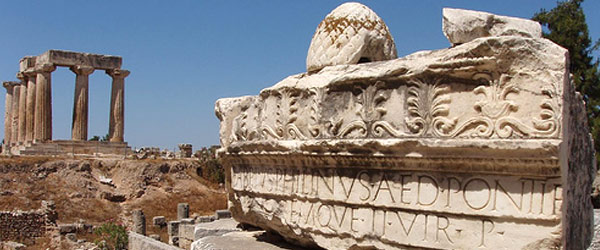
Babbius Philinus inscription - Ancient Agora Corinth
Actually, he must be of greek origin as we can conclude from the name Philinus which is greek. The thing is that he was really interested in Corinth and he took care of decorating the city with the elegant round marble Agora building.
North side of the Ancient Agora of Corinth
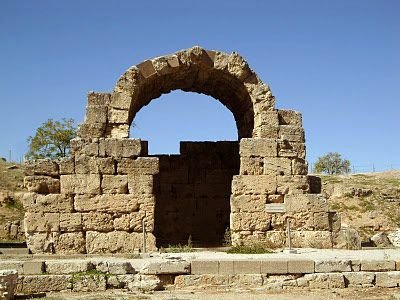
Northwest shops of the Ancient Agora of Corinth
There is a series of sixteen small buildings which have survived in a good condition and date to the imperatorial era. The central one which had a vaulted roof was used as a church. A vaulted worship-related building was found under the foundations of the eastern rooms and it dates back to the 6th century BC. It must have been related to a sacred spring situated to the south, in the central area of the Agora and lower than the ground level. The spring could be accessed via steps that were built some years later, during the autonomy of Corinth. A wall decorated with triglyphs and metopes had been constructed at the part of the spring which could be seen easily.
On the east side of these buildings, there was an imposing façade that belonged to a basilica which was situated to the north (along the west verge of Lechaiou street). The façade that looked towards the centre of the Agora had an upper level. The entablature of the upper lever had the same number of columns as the ground one yet four of the upper middle-columns had been replaced by four vast sculptures icons depicted the barbarians holding the entablature.
An imposing propylon had been built to the east at the beginning of Lechaiou street. The propylon had been restored several times according to various designs. One of them consisted of a large central arc-shaped span and another lower span on each side. Gold-filled chariots of Helios and Faethon had been placed over the central arc.
Centre of the Ancient Agora of Corinth
Possibly, a part of the central space of the Agora was used as a stadium during the years od the autonomy of Corinth. The stone constructed starting-point of the Games can be seen under the stairs of the basilica entrance. A big statue of Athena had been placed in the central space of the Agora, during the roman era. An altar where public sacrifices were taking place had also been built there.
The basilica on the east side of the central area is considered to have been built by Augustus’ family who also initiated the restoration of the city. Parts of statues probably devoted to Julius Caesar and Augustus have been found in the basilica which was used for trials and public assemblies.
A series of small oblong rooms was found to the south and a structure which was used as the podium from where the Roman proconsul was addressing to the
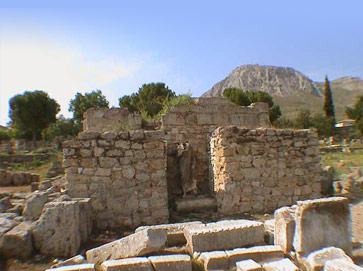
Ancient Agora Podium
citizens, had been erected in the middle of the central outdoors space. Saint Paul had presented to the Roman proconsul Lucius Julius Gallio (brother of the philosopher Seneca in 52 AD, who had been accused by the Jewish for undermining the Mosaic Law, causing fusses between the Jewish and the followers of Saint Paul. However, Gallio decided that Saint Paul’s teaching didn’t consist any offence that should be published according to the Roman Law. The3 fact that Gallio did not disturb Saint Paul was an important factor that contributed to the early creation of the Christian church of Corinth. For this reason, a small church with three arc on its east side was built during the medieval age, at the place where the podium had been located. The remains of the church can be seen even nowadays.
South side of the Ancient Agora of Corinth
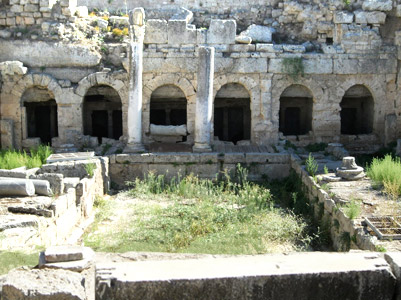
Peirene Spring
A long arcade (160 m long) with 71 columns on its façade had been built in thePeirene Spring 4th century AD behind the small central buildings. There was also an interior series of 34 ionic columns and a series of 33 rooms, each of which had two levels. There were wells through which water from Peirene spring was brought to each room. A pipe transferring water had also been constructed along the arcade, under the floor of each front room. A series of public stores had been built behind this arcade as well as a roman basilica which was used in the same way as the basilica of the east side.
Lechaiou street ancient Agora of Corinth
A few steps let people pass from the propylon of the south side of the agora to the slab paved area of Lechaiou street. Two narrow pavements with curbs had been constructed on both left and right side of the street which was surrounded
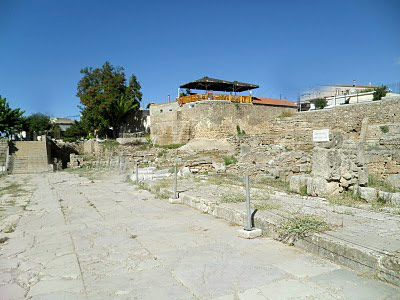
Lechaiou Street
by arcades. Several stores had been built opposite the street (to the south). A semi-circular arcade was built later on the left pavement of Lechaiou street.
Peirini spring was situated on a lower lever than the ground surface and people used to reach by descending some steps.
Three arcs and marble walls were constructed during the 2nd century AD by Herodes Atticus. A central yard existed even earlier. Six openings had been created on its south side, which were connected with six water pumping basins which had been placed on a lower level than that of the yard and could be reached by people through some steps.
The rectangled space to the north of the spring was used as the parvis of Apollo’s sanctuary where outdoors religious and public events were carried out. During the pre-roman era, there was a small chapel devoted to Apollo. Its foundations were preserved under the walls of the roman stores. A building that looked like a bath was found during excavation on the north part of the parvis. Probably it belonged to Eurecles’s Baths.
Public buildings (Theatre, Odeion, Temples and Shrines) of the Ancient Agora of Corinth
The ruins of the Theatre of Corinth can be seen to the west of the archaic
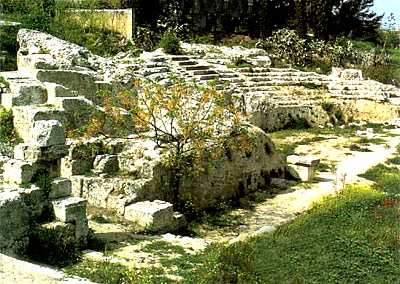
Ancient Corinth theatre
temple, as it was constructed during the roman era. Another theatre had been built at the same position in the 4th century BC and some slight evidence of it has survived nowadays.
The axis and the foundations of the Roman Odeion can be seen to the south. On the east side of the Odeion, there must have beem built a shrine devoted to Athens chalinitida. The goddess must have been named after the halter (“chalinari”) Athena had given to Velerefondis in order him to break the wing-horse Pegasus.
Directing to the south, one can see the ruins of a spring called Glafki which was carved in a rock and was provided with water through a pipe that came from the south side. Continuously, there is a temple to the east, probably devoted to Hera whose worship was transferred from Corinth to Perachora. The temple was built after the reconstruction of Corinth during the roman era.
